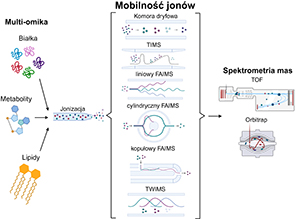Ion Moblity Mass Spectrometry in Multi-omics Studies
DOI:
https://doi.org/10.18388/pb.2021_530Abstract
Mass spectrometry (MS) as an analytical technique enables the identification and quantitative determination of proteins, metabolites, or lipids in a studied sample. However, this method has limitations regarding the number of molecules that can be identified at a given time. To increase the number of identifications, the application of ion mobility spectrometry (IMS) can be employed. This technique allows the separation of ions based on their mobility while traversing the analyser in a gradient of an electromagnetic field and opposing gas pressure. The separation is performed in conjunction with MS analysis, adding another dimension to the analysis, resulting in a significant improvement in the number of identified compounds and a reduction in noise. Alternatively, while maintaining the same number of identifications, analysis can be performed in a shorter time period. It is crucial to pay special attention to the type of IMS analyser used, as its specific implementation dictates further stages of analysis and ion detection capabilities.

Published
License
Copyright (c) 2024 Daniel Fochtman, Anna Wojakowska, Łukasz Marczak

This work is licensed under a Creative Commons Attribution 4.0 International License.
All journal contents are distributed under the Creative Commons Attribution-ShareAlike 4.0 International (CC BY-SA 4.0) license. Everybody may use the content following terms: Attribution — You must give appropriate credit, provide a link to the license, and indicate if changes were made, ShareAlike — If you remix, transform, or build upon the material, you must distribute your contributions under the same license as the original. There are no additional restrictions — You may not apply legal terms or technological measures that legally restrict others from doing anything the license permits.
Copyright for all published papers © stays with the authors.
Copyright for the journal: © Polish Biochemical Society.



